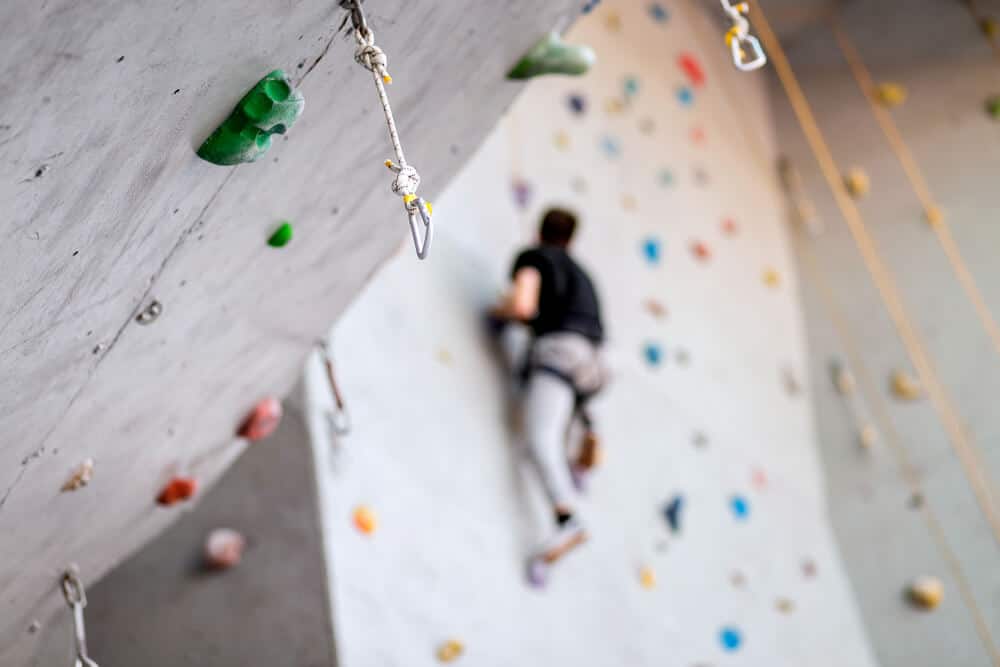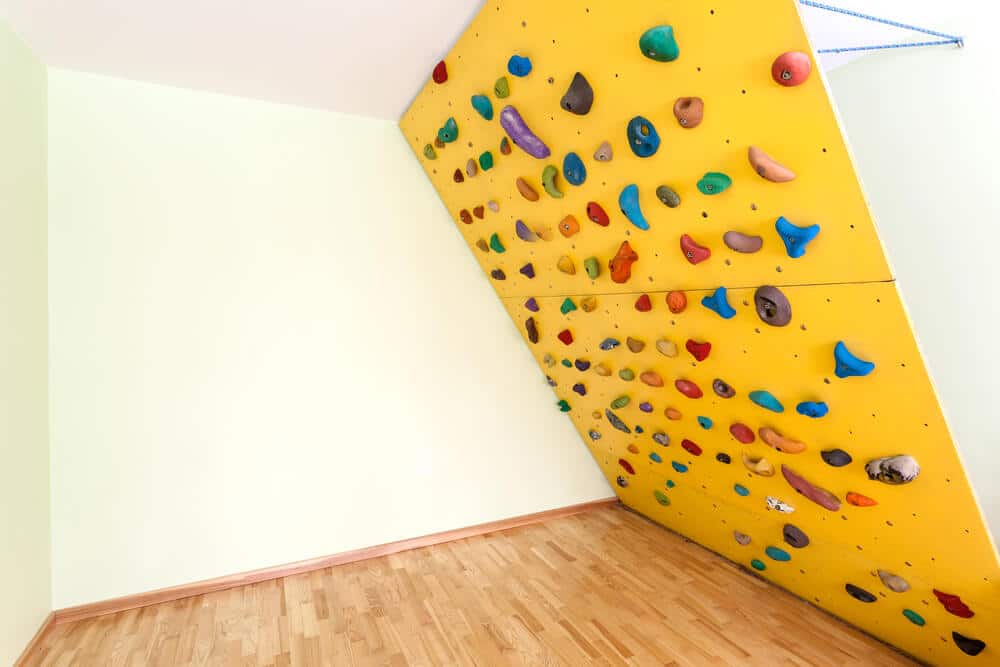At some point in our climbing careers we’ve all dreamed of opening our own rock climbing gym. Maybe it was just a passing thought, or maybe we seriously started crunching some numbers. Some of us even followed through! (A couple friends of mine actually have opened their own climbing gyms.)
Most of us, however, either resigned ourselves to a membership at the local plastic puller’s club, or built our own makeshift walls in the garage. But how much would it actually cost to open a commercial climbing gym? On the flip side, how much would it cost to build your own climbing wall?
There are a number of factors that will influence the cost of climbing walls, including size, access, height, design, and location. In this post, I’ll attempt to break down the costs of building climbing walls, both in a large-scale, commercial setting and a DIY home gym.
Building Commercial Climbing Gyms
I doubt anyone will be surprised to learn that commercial climbing gyms are much more expensive that DIY home gyms. Climbing gym consulting firm IMPACT estimates the average start up cost for a fully-operating climbing gym business is between $250,000 and $500,000, assuming the standard gym size of around 4,000 to 12,000 square feet. For a large rock climbing gym, or one in an area with a high cost of living like Los Angeles or New York City, this cost can soar even higher to upwards of $1,000,000.
Also, this estimate assumes that the rock climbing gym location is already ready to roll. If you’re purchasing land, constructing the building that will house the climbing wall, or doing some serious internal renovations, then your start-up costs are going to be higher.
There are a few considerable differences between building and operating a commercial climbing gym and DIYing it yourself at home.
What’s more, costs are going to vary so wildly depending on size and location that I can’t pretend to estimate them here. Instead, I’ll simply try to give a list of things you should research and keep in mind as you plan.
Insurance
Like any business, property insurance is necessary to protect your rock climbing gym from damages. For obvious reasons, commercial climbing gym owners also need liability insurance.
Rates for liability insurance will vary depending on many factors, including allowed ages, membership size, and whether your gym is bouldering-only or includes lead climbing, autobelays, and the like. Assume that insuring your rock climbing gym will cost about 2% to 3% of your annual revenue.
Climbing Gym Size and Location
The location of a rock climbing gym will make or break the success of your business. For starters, the gym has to be in a relatively safe, accessible area where members will want to come and climb. If it’s way out in the boonies, no one’s going to make the trek to rope up with you. Find a suitable location before you do anything else.
Also, the venue must be appropriately sized and ventilated. The biggest thing here is height. You can’t have a climbing wall in a one-story building. Most roped climbing walls are between 20 and 45 feet. A bouldering wall is shorter, but still tall enough to require a two-story space. An average bouldering wall is around 10 to 15 feet, and you need roof space above that, too.
As a result, most rock climbing gyms work best in a high-ceiling warehouse. In terms of area, climbing gyms can be as big as you’d like, but on the small end, you’ll need a 4,000 square foot space.
Remember, artificial climbing walls also aren’t entirely made up of linear, vertical wall. They are overhung and slabby, concave and convex, bending in a variety of angles. So when estimating wall square footage, after multiplying height by length, account for climbing surface irregularity by adding a factor of 1.3x. Costs vary, but for a commercial gym average around $30 to $40 per square foot.
Rent, Utilities, and Maintenance
You’ll need to rent or lease the facility to house your rock climbing gym. This is a big cost, but will vary widely based on location. Rent in New York City is in a whole different ballpark than rent in rural Mississippi. Average U.S. rent is rising quickly, however. Last fall, the Wall Street Journal reported figures nearly $10 per square foot for industrial space. If your gym is 6,000 square feet, that’s $60,000 in rent. Ouch.
In addition to rent, you need to pay for utilities like electricity, HVAC, water, and plumbing. You need to purchase safety equipment, such as ropes, rental harnesses and shoes, auto belays, and anchors.
You need to repair and maintain both this equipment, and the rock climbing gym facilities. Maintaining climbing equipment costs about 10% to 20% of the original purchase price annually. Maintaining the gym itself is also important.
This doesn’t just mean coming up with bomber new routes and scrubbing chalk, unfortunately. It also means plunging toilets and scraping up birthday party kids’ vomit. Annual maintenance costs for U.S. climbing walls run between $10,000 and $30,000, but vary vastly depending on the size of the operation.
Marketing
To tie in and get your rock climbing gym off the ground, you need to identify a target audience and successfully advertise your gym to that target market to get new customers.
Marketing can include website design, search engine optimization and advertising, social media strategy, email and SMS, and perhaps print advertising. You’ll need to work on brand recognition, design a memorable logo… the list goes on. For most companies, marketing budgets account for around 7% to 8% of annual revenue.
Employees
You can’t run a climbing gym alone. You’ll need to find, train, and pay staff. The average salary for a climbing gym employee in the United States currently is between $10 and $15 per hour, but can be higher depending on minimum wage in your gym’s city and state. Gmy managers will command a higher salary.
Financing Commercial Rock Climbing Gyms
Climbing gyms are financed in all manner of ways. I’ve seen gyms financed through Small Business Administration (SBA) loans, through Kickstarter and GoFundMe, and through rich mommies and daddies.
Most successful gyms secure at least 50% of start-up costs by the founders pooling resources, and secure the rest via traditional bank financing. Others solicit investors and sell ownership to a larger group of limited partners. The tradeoff here is that you’re selling pieces of your business out to others. Risk is diffused throughout the group, but so is control. It can become hard to make decisions.
But look, chances are if you’re seriously thinking about pumping out quarter-million dollars to finance a climbing gym, you aren’t getting your info from some guy on FlashPumped. (At least I hope not.) I’ve been climbing for a long time, but I’m no financial consultant.
Hopefully the above has at least given you a basic idea of the path ahead. Now go do thorough market research, formulate a business plan, set up a limited liability company, and all that other stressful stuff…
Let’s move on into the DIY section, which is more applicable for most of us.
Bouldering Wall Cost vs Roped Climbing Wall Cost
Before we talking about making rock climbing walls at home, let’s breakdown bouldering vs. roped climbing. There’s a reason most new gym owners opt for a boulder-only approach, as do 99% of all DIYers. Bouldering walls are much cheaper and simpler than roped climbing walls.
They’re smaller (1/2 to 1/4 the height) and require no anchor systems, bolts, auto belays, harnesses, ropes, belay devices, carabiners, or other gear to use, which is a big cost if you’re a commercial gym. They also don’t require participants to pass belay tests, which means reduced staff training, too.
That’s not to say you can’t get hurt bouldering (in fact, bouldering is more likely to result in injury than roped climbing), but injuries are typically much less serious.
Building Climbing Walls at Home
Many climbers who toy with the idea of building a commercial climbing gym ultimately choose to build their own “gym” at home, perhaps in a garage or backyard shed. Naturally, this is a much more affordable way to build a climbing gym.
A pre-fabricated climbing wall like a MoonBoard, Kilter Board, or TensionBoard allows you to smash a ton of training potential into a small space. However, they’re far more expensive than a true DIY project. Full-fledged MoonBoard DIY kits, for example, are around $4,000. TensionBoard wall sets (minus panels and hardware) are around $1,500 to $2,000.
If you’re looking to build an at-home rock climbing gym as cheaply as possible, building your own wall organically is the best move. A basic vertical wall can cost as little as $300. An overhung spray wall will be closer to $500 to $750.
To get an idea of what your wall will look like, it’s smart to do a digital mockup. Sketchup is a popular (and free) tool for this. Once you have a rough idea of how you want your wall to look, you can go out and purchase materials.
All you really need is plywood, studs (spaced 16 to 24 inches apart), hardware (wood screws, joints, t-nuts, and bolts), and your climbing holds. An angled wall is slightly more expensive than a vertical wall because it’s under heavier loads. Vertical walls can use 2x4s for studs, angled require 2x8s. Below is a mock price breakdown for a 8×8 foot overhung wall.
- 4×8 foot panel of plywood (2x) = $60
- 2×8 studs (6x) = $60
- Wood screws (3x pack) = $36
- Wood Joints (4x) = $4
- T-nuts (250x) = $35
- Climbing holds (40) = $200
So we come out to $395. Remember, this doesn’t include all the tools needed, such as a hammer, tape measure, power drill, level, and saw, to name just a few. Also, these prices will vary. You can find 40-pack of rock climbing holds for much cheaper than $200, for example. Anyways, add an old mattress or some crash pads and you have a wall.
Conclusion
Building a climbing wall can vary from $1,000,000 to $300. Building and operating your own commercial rock gym will no doubt be extremely rewarding, but this will be an intense, all-encompassing project with high risk.
Building your own climbing wall at home, meanwhile, is a relatively simple project that can be done wiht a free weekend, some basic carpentry, and a few hundred dollars.











